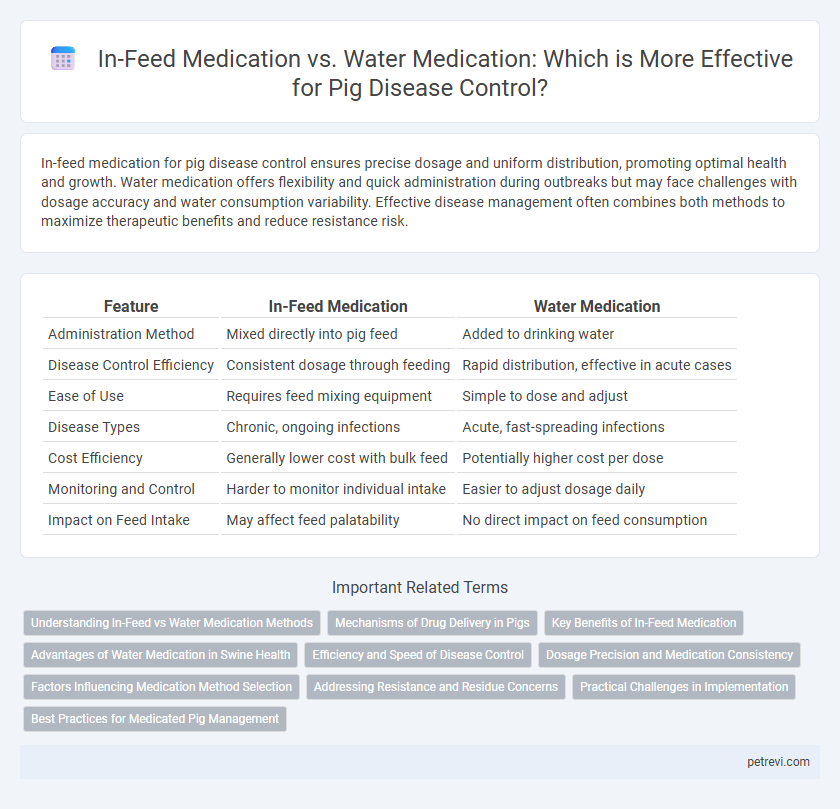In-feed medication for pig disease control ensures precise dosage and uniform distribution, promoting optimal health and growth. Water medication offers flexibility and quick administration during outbreaks but may face challenges with dosage accuracy and water consumption variability. Effective disease management often combines both methods to maximize therapeutic benefits and reduce resistance risk.
Table of Comparison
| Feature | In-Feed Medication | Water Medication |
|---|---|---|
| Administration Method | Mixed directly into pig feed | Added to drinking water |
| Disease Control Efficiency | Consistent dosage through feeding | Rapid distribution, effective in acute cases |
| Ease of Use | Requires feed mixing equipment | Simple to dose and adjust |
| Disease Types | Chronic, ongoing infections | Acute, fast-spreading infections |
| Cost Efficiency | Generally lower cost with bulk feed | Potentially higher cost per dose |
| Monitoring and Control | Harder to monitor individual intake | Easier to adjust dosage daily |
| Impact on Feed Intake | May affect feed palatability | No direct impact on feed consumption |
Understanding In-Feed vs Water Medication Methods
In-feed medication for pigs ensures controlled, consistent dosing through daily feed intake, optimizing nutrient absorption alongside disease control. Water medication offers rapid administration and flexibility during outbreaks, enabling immediate response with easily adjustable dosages. Selecting between these methods depends on factors such as herd size, disease severity, and medication type for effective pig health management.
Mechanisms of Drug Delivery in Pigs
In-feed medication delivers drugs through ingestion during regular feeding, ensuring consistent dosage as pigs consume their feed, which benefits gut-targeted treatments by direct contact with intestinal mucosa. Water medication allows rapid administration and dosing flexibility, enabling precise adjustment based on water intake fluctuations that can vary with environmental and health conditions. Both methods rely on absorption through the gastrointestinal tract but differ in control over individual dosages and onset of therapeutic effects.
Key Benefits of In-Feed Medication
In-feed medication for pig disease control ensures precise and consistent dosage, enhancing the effectiveness of treatment while minimizing stress during administration. It promotes uniform drug intake among pigs, reducing the risk of underdosing or overdosing compared to water medication. This method also maintains medication stability and palatability, supporting better overall health and growth performance in swine herds.
Advantages of Water Medication in Swine Health
Water medication offers precise dosage control and rapid administration, ensuring effective treatment of pig diseases with minimal stress to the animals. It promotes better uniformity in drug intake compared to in-feed medication, facilitating quicker therapeutic responses and reducing the risk of medication underdosing or overdosing. Enhanced bioavailability through water medication improves disease control efficiency, ultimately supporting optimal swine health and growth performance.
Efficiency and Speed of Disease Control
In-feed medication allows precise dosage tailored to individual pig weight, ensuring consistent intake and faster stabilization of therapeutic levels, while water medication offers rapid mass treatment suitable for acute outbreaks but risks dosage variability due to inconsistent water consumption. Studies show in-feed medication delivers sustained drug levels, enhancing disease control efficiency over time, whereas water medication provides quicker initial response but may require repeated dosing to maintain effectiveness. Optimizing medication method depends on disease severity, pig behavior, and production goals for maximizing efficiency and speed in pig health management.
Dosage Precision and Medication Consistency
In-feed medication provides precise dosage control by incorporating exact amounts of active ingredients tailored to individual feed rations, ensuring consistent therapeutic levels in pigs. Water medication, while easy to administer, often suffers from dosage variability due to fluctuations in water intake influenced by temperature, health status, and environmental factors. Consistent medication delivery through feed minimizes underdosing or overdosing risks, enhancing disease control and promoting better overall pig health outcomes.
Factors Influencing Medication Method Selection
Factors influencing the selection between in-feed medication and water medication for pig disease control include medication accuracy, ease of administration, and pig consumption behavior. In-feed medication ensures consistent dosage through controlled feed intake but may be less effective during reduced appetite or feed refusal episodes. Water medication allows rapid delivery and flexibility during acute outbreaks but requires careful monitoring of water intake and dosage stability to avoid under- or overdosing.
Addressing Resistance and Residue Concerns
In-feed medication for pigs allows precise dosing but can lead to uneven drug intake and prolonged exposure, increasing the risk of antimicrobial resistance and drug residues in tissues. Water medication offers rapid distribution and easier adjustment of dosage, potentially reducing resistance development and residue accumulation when managed properly. Both methods require careful monitoring and adherence to withdrawal periods to effectively address resistance and residue concerns in pig disease control.
Practical Challenges in Implementation
In-feed medication faces challenges such as uneven drug intake due to variations in individual pig feeding behavior and feed mixing inconsistencies, potentially reducing treatment efficacy. Water medication struggles with dosage accuracy because of fluctuating water consumption rates influenced by environmental factors or health status. Both methods require careful management to prevent underdosing or overdosing, which can lead to drug resistance or treatment failure in pig disease control.
Best Practices for Medicated Pig Management
In-feed medication offers precise dosage control and ensures consistent intake for growth-promoting and disease-preventing purposes in pigs, making it ideal for chronic or long-term conditions. Water medication provides rapid drug delivery during acute outbreaks and is useful for pigs with reduced feed consumption, although maintaining water quality and accurate dosing is critical. Best practices include monitoring pig health closely, ensuring medication uniformity, and adhering to withdrawal periods to optimize therapeutic outcomes and minimize antimicrobial resistance.
In-feed medication vs Water medication for Pig disease control Infographic

 petrevi.com
petrevi.com